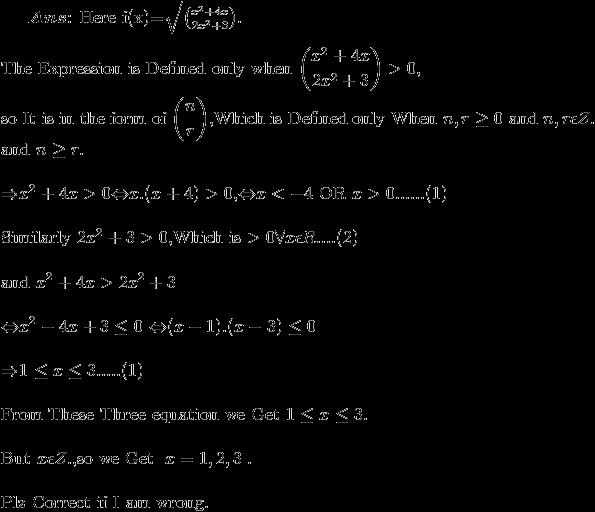1) f(x) = √x² - |x| - 2
We impose various restrictions(set theory ke mutaabik) as per definition of functions involved. Then we take intersection of those restrictions to get the domain.
R1 : Square root function. For √x, x ≥ 0.
So x² - |x| - 2 ≥ 0
=> |x|² - |x| - 2 ≥ 0 (As x² is the same as |x|²)
=> (|x| + 1)(|x| - 2) ≥ 0
Using the wavy curve method, we can easily see that |x| ≤ -1 U |x| ≥ 2 for the inequality to be satisfied(where U is union).
As |x| ≤ -1 is not possible, we discard it from the union(As any set U Null set = the set itself).
So |x| ≥ 2 or x ≤ -2 U x ≥ 2.
Hence R1 -> x ≤ -2 U x ≥ 2
R2 : Modulus function. For |x|, x ≥ 0.
Here simply x ≥ 0.
Now taking intersection, R1 ∩ R2 => x ≥ 2 is the domain of the function...
2) Dunno bout this one...it never came right for me when I tried it.
3) You have to be careful of the base of the logarithms here.
As per def of log function,
log2log2/π(Y) ≥ 0 where Y is (tan-1x)-1 for simplicity.
=> log2log2/π(Y) ≥ log21
=> log2/π(Y) ≥ 1
=> log2/π(Y) ≥ log2/π(2/π)
=> Y ≤ 2/π [Note the inequality change, this is because logarithm base was smaller than 1].
=> 1/tan-1x ≤ 2/π
I think we can cross multiply. This is because 1/tan-1x will have to be positive anyway, for the rest of the logs to work. Sooo...
=> tan-1x ≥ π/2...
Feeling sleepy...lol...I'll be back for the rest later [13]

